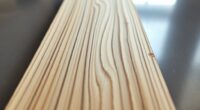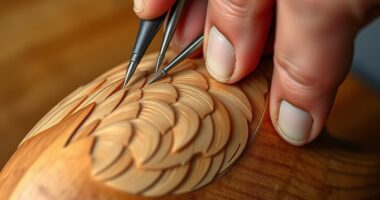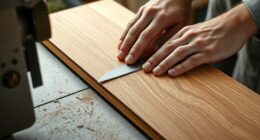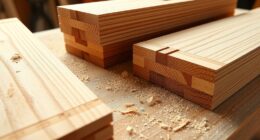To carve a chainsaw bear as a beginner, start with safety gear like goggles and gloves, and grab a simple pattern to follow. Use your chainsaw for large shapes and switch to smaller tools for details. Keep your work steady, cut away from your body, and take your time. Pay attention to the wood grain and maintain tools properly. If you keep practicing these steps, you’ll create an impressive bear—more tips are just ahead to help you succeed.
Key Takeaways
- Start with a clear, beginner-friendly bear pattern and sketch it onto the wood for guidance.
- Use a chainsaw for rough shaping, focusing on large cuts following the pattern outline.
- Switch to smaller tools like chisels and gouges for fine details such as facial features and claws.
- Prioritize safety by wearing protective gear and maintaining proper tool maintenance throughout.
- Regularly evaluate your progress, take breaks, and work deliberately for accurate, detailed results.

If you’ve ever wanted to create a striking wood sculpture, carving a chainsaw bear is an exciting project that combines skill and creativity. Before you start, it’s crucial to prioritize chainsaw safety. Always wear protective gear, including goggles, ear protection, gloves, and a sturdy apron. Make sure your chainsaw is in good condition and sharpened properly; dull blades can cause accidents and make carving more difficult. Keep a firm grip on the saw, and be aware of kickback hazards by maintaining proper stance and cutting techniques. Safety isn’t just a precaution — it’s an essential part of ensuring you enjoy the process without injury.
Once you’re equipped with basic safety knowledge, gather your carving tools. Besides your chainsaw, you’ll want smaller tools like chisels, gouges, and rasps to refine details later. Start with a rough sketch of your bear pattern on the wood block, which helps visualize the final piece and guides your cuts. When you’re ready to begin, use your chainsaw to remove large chunks of wood, following your outline. Take your time with these initial cuts, focusing on controlling the saw and maintaining steady, deliberate movements. Keep your workspace clean and clear of debris to prevent accidents, and never force the saw through the wood — let the tool do the work.
Gather your carving tools and sketch your bear before starting to carve.
As you carve, switch between the chainsaw and smaller carving tools to add detail and refine shapes. Use the chainsaw for broad, sweeping cuts to shape the body and limbs, then switch to chisels or gouges for facial features, claws, and fur texture. Always cut away from your body and maintain a balanced stance to stay in control. Pay close attention to the grain of the wood, as it affects how the wood responds to your tools and can influence your carving direction. Take breaks frequently, especially if you start to feel fatigued or strained, because precision and safety go hand in hand.
Throughout the process, keep your carving tools sharp and well-maintained. Dull tools make carving more hazardous and less effective, forcing you to apply more pressure and risking slips. As you progress, step back periodically to assess your work and ensure your proportions and details are accurate. Remember, patience is key. Rushing can lead to mistakes or accidents, so take your time with each cut. With careful attention to chainsaw safety, proper use of carving tools, and steady, deliberate effort, you’ll craft a beautiful chainsaw bear that’s both impressive and safe to create.
Frequently Asked Questions
What Safety Gear Is Essential for Chainsaw Carving?
When working with a chainsaw, safety gear is essential to safeguard yourself from potential injuries. Always wear protective gear like safety goggles or a face shield to guard your eyes from debris, ear protection to prevent hearing damage, and sturdy gloves for hand safety. Safety precautions also include wearing a helmet with a chin strap and durable clothing. These steps help minimize risks and ensure a safer carving experience.
How Long Does It Typically Take to Complete a Chainsaw Bear?
Timing expectations for carving a chainsaw bear vary based on your skill development and project complexity. As a beginner, you might spend several hours or even a few days completing it, depending on your comfort with the tools. With practice, your speed improves. Remember, patience is key. Focus on skill development first, and the time it takes will decrease as you gain confidence and experience.
Can Beginners Successfully Carve a Detailed Bear Pattern?
They say, “Every expert was once a beginner,” and that’s true when it comes to carving detailed bear patterns. As a beginner, you can succeed with patience and practice. Using beginner techniques will help you overcome carving challenges, like achieving smooth details and proper proportions. Start with simple patterns, follow instructions carefully, and don’t rush. With time and effort, you’ll see progress and create impressive carvings.
What Type of Wood Is Best for Chainsaw Bear Carving?
When choosing wood for your chainsaw bear carving, focus on softwoods like pine, cedar, or basswood. These woods are easier to carve, helping you refine your carving techniques and achieve smoother details. Avoid hard or dense woods initially, as they can be tough to work with and may cause your tools to dull quickly. Proper wood selection makes your carving experience more enjoyable and your finished piece more professional.
How Do I Maintain and Sharpen My Chainsaw for Carving?
Think of your chainsaw as a trusty steed that needs regular grooming. For chainsaw maintenance, check the chain tension and oil levels often. When sharpening, use proper sharpening techniques with a file or grinder, focusing on keeping the teeth even and sharp. This keeps your chainsaw slicing through wood like a hot knife through butter. Regular care guarantees smooth carving, prolongs your tool’s life, and keeps your creative sparks flying high.
Conclusion
Now that you’ve got the basics down, carving your own chainsaw bear becomes a rewarding project. Did you know that chainsaw carving has grown in popularity by over 30% in the last five years? With patience and practice, you’ll improve each time. Remember, every artist starts as a beginner, so don’t get discouraged. Keep honing your skills, and soon you’ll be creating impressive sculptures that showcase your unique style. Happy carving!









